Data Acquisition Systems
Data acquisition systems are used to convert analog waveforms into digital values that can be used for processing. This conversion is possible due to the data acquisition process, which is the sampling of actual physical phenomena (e.g. light, fluid, gas). Sensors in a data acquisition system intake these phenomena as analog signals and route them to specialized hardware, which subsequently converts the analog signals into digital numerical values. By the end of this process, the original data has been converted into a unified form that a computer can interpret and analyze.
Data acquisition systems can be represented by the acronyms DAS or DAQ. DAQ is shorthand for "data acquisition" and is interchangeably used to refer to the process of data acquisition as well as the wide range of technologies used in the process of data acquisition (hardware components, software components, or both). Accordingly, the acronym DAS is more accurate to refer to data acquisition systems as a whole.
Quick Links to Data Acquisition Systems Information
History of DAS
Modern data acquisition systems are, relatively speaking, a very recent invention. The basic premise behind DAS is simply that data can be recorded in a useful form that can subsequently be interpreted and used for practical purposes. Based on this premise, the act of recording thermometer readings by hand and taking action based on those readings technically represents a data acquisition system.
The origin of modern DAS can be traced back to IBM’s creation of elaborate computer-and-hardware complexes during the early 1960s. The very first data acquisition machine, called the IBM 7700 Data Acquisition System, appeared in 1963. The 1800 Data Acquisition and Control System appeared the following year; its main innovation was a complex disk storage system. In 1981, IBM Personal Computer and Scientific Solutions appeared, representing the first DAS integrated with personal computer (PC) technology.
Over time, DAQ systems have become increasingly simple and increasingly powerful. DAS today is typically fully electronic and capable of processing multiple channels of input. Today, the global DAS market continues to grow rapidly; some estimates put predicted growth at close to 40% over a five-year period (2015-2020).
Advantages of DAS
The use of data acquisition systems offers a wide range of benefits. The accuracy, flexibility, simplicity and powerful processing capabilities that characterize modern DAS are all harnessed by a wide variety of industries to increase productivity and cost-effectiveness. The initial design of these database systems and initial investments in appropriate hardware/software (as well as training) can be burdensome in terms of time and financial resources. Over time, however, conversion to and use of DAS generally outweighs any up-front costs.
How Data Acquisition Systems Work
For data acquisition systems to fulfill their intended use, they must acquire some type of data. Virtually any type of physical property is measurable by data acquisition systems. Examples of phenomena commonly sampled by DAS systems include light intensity, fluid flow, gas pressure, temperature and force. These phenomena can be represented by analog signals - any type of continuous signal characterized by level (or intensity) and frequency (variation over time). Practically speaking, the term analog signal is almost synonymous with electrical signal, since electricity is one of the most common phenomena representative of an analog signal. Sensors in a DAS translate their interaction with physical phenomena into a wide variety of electrical signals such as voltage, current, and resistance.
The electrical signals produced by the sensor form the basis of digital values, which lie at the heart of data acquisition systems. However, an intermediate step must occur for the electrical signals to be able to be converted into digital values. This intermediate step is known as conditioning and is performed by the signal conditioning circuitry, the initial piece of a DAS’s hardware system. This circuitry often doubles as the sensor’s power source. Conditioning is necessary because electrical signals are extremely prone to distortions that make them difficult to interact with.
Conditioning a signal can take place through a variety of methods. Two common methods are amplification and filtering. As sensors interact with physical phenomena, they remove energy from physical systems under investigation; thus, sensors are often intentionally designed to remove a minimum amount of energy from the physical systems they interact with. The electrical signal resulting from this energy, however, is too small to or low intensity to be readily converted into a digital form. Amplifying this signal allows it to attain a state where it can then undergo digital conversion. Even if an electrical signal does not require amplification, it usually requires filtering since most signals are too noisy (e.g. blurred by electrical interference) or high intensity (i.e. characterized by high frequency) to be smoothly digitized. Filters (often located after amplifiers) change the signal into a state where it is conversion-ready for digitization.
Once an electric analog signal has been conditioned, it is finally ready to undergo digital conversion. Analog-to-digital converters (ADCs) are chips that perform this conversion and represent the "heart" of data acquisition systems. ADCs sample conditioned signals at regular intervals before translating them into binary, digital data (e.g. 1 or 0, on or off, high or low). The sampling frequency of these ADCs is extremely rapid - usually under a second. Once binary values are obtained, they are themselves translated into normal, digital base numbers. ADCs are capable of switching rapidly between multiple channels of input while performing this analog-to-digital conversion.
Once digitized, signals must be transferred to some type of user-friendly computer for a DAS to be functionally useful. The portion of a DAS responsible for this transport is usually referred to as a bus. Although it is sometimes considered separately, the bus is often categorized under DAS hardware as a whole. The DAS components responsible for digitizing and transporting data -- the signal conditioner, ADC, and bus can be collectively referred to as a data acquisition module. In addition to a variety of devices and components, there is a broad range of methods in which data acquisition through a bus can be achieved. These different methods depend on the type of telecommunications protocol in question. Personal computer (PC) data acquisition is widely used in industrial applications. This method characterizes the vast majority of data acquisition systems and devices and requires some sort of connection to a host computer in order to function and properly download the collected information. There are many types of data acquisition devices that plug directly into the host computer in order to function. PC data acquisition utilizes different types of ports (e.g. parallel, serial, USB, Ethernet). The most common types of port connections use the General Purpose Interface Bus (GPIB, HPIB or IEEE 488), a universal serial bus (USB) connection, or an Ethernet connection. Wireless DAS connections (known as DAQifi) are a recent development. Data acquisition cards that plug into a computer (to be discussed in the following section) represent an alternate method of connecting DAS hardware and software.
If the ADC can be visualized as the "heart" of a DAS, the computer of a DAS can be visualized as the "brains" of the entire system. The reason for this is the fact that a DAS’s software portion controls the entire system and transforms digital data into a form that can be understood and used by an end user. Computers in a DAS usually possess two types of software: application software and driver software. Application software enables an end user to interact with the computer (e.g. providing a usable human-machine interface for process control response), while driver software enables the application software itself to communicate with the rest of the DAS.
Choosing DAS
A fundamental trait of DAQ systems is variety. Thus, the key to choosing the right DAS and the right manufacturer for that DAS is careful consideration of your specific DAS application(s). Keep in mind that the specificity of your application should also be balanced with the overall flexibility of your DAS solution. Furthermore, since different types of DAS do share a few fundamental features, these must also be carefully considered; for example, the type and performance of an ADC or a computer software package are critical for ensuring a high quality DAS.
The following examples illustrate (at a very high level) how the choice of a DAS is completely dependent on its intended use:
- Measuring Through a DAS Sensor
- It has been previously stated that almost every physical property can be measured to some degree by some type of DAS sensor. Rarely, though, does every variable in a physical environment need to be measured in an industrial operation. Thus, it is more prudent to choose a DAS with the minimum number of required sensors rather than one with a plethora of available sensors. Obviously, knowing a minimum number of required sensors is impossible without knowing exactly what type of data you need to measure.
- Power Provision
- USB data acquisition offers several advantages for DAQ systems including the ability to provide power to peripheral devices as well as offering a higher bandwidth (with capabilities of reaching 12 Mbits/s). Since USB devices are used in order to supply power, only one cable is required to link the data acquisition device to the computer, which will likely feature at least one USB port.
- The computer component of a DAS is heavily influenced by the environment the DAS will operate in. For field operations, a DAS compatible with a laptop is preferred. If processing power is a greater factor than portability, a DAS compatible with a desktop or even a heavy industrial computer is the likely better choice.
- Wireless Connections
- DAS that operates with a wireless connection between hardware and software (DAQifi) may be advantageous for a variety of situations where cheaper up-front costs, flexibility, and portability is paramount.
- Data Loggers
- Well suited to identify irregular patterns over a prescribed period of time. They work well for design verification purposes in product development environments. They are also well suited for field operations due to their portability.
- Switch Box
- Can be used as a type of DAS for many industrial testing and verification purposes. Typically, switch boxes are used as a conduit for signals between test subjects and different types of test and measurement equipment (e.g. oscilloscopes, counters).
Data Acquisition System Images, Diagrams and Visual Concepts
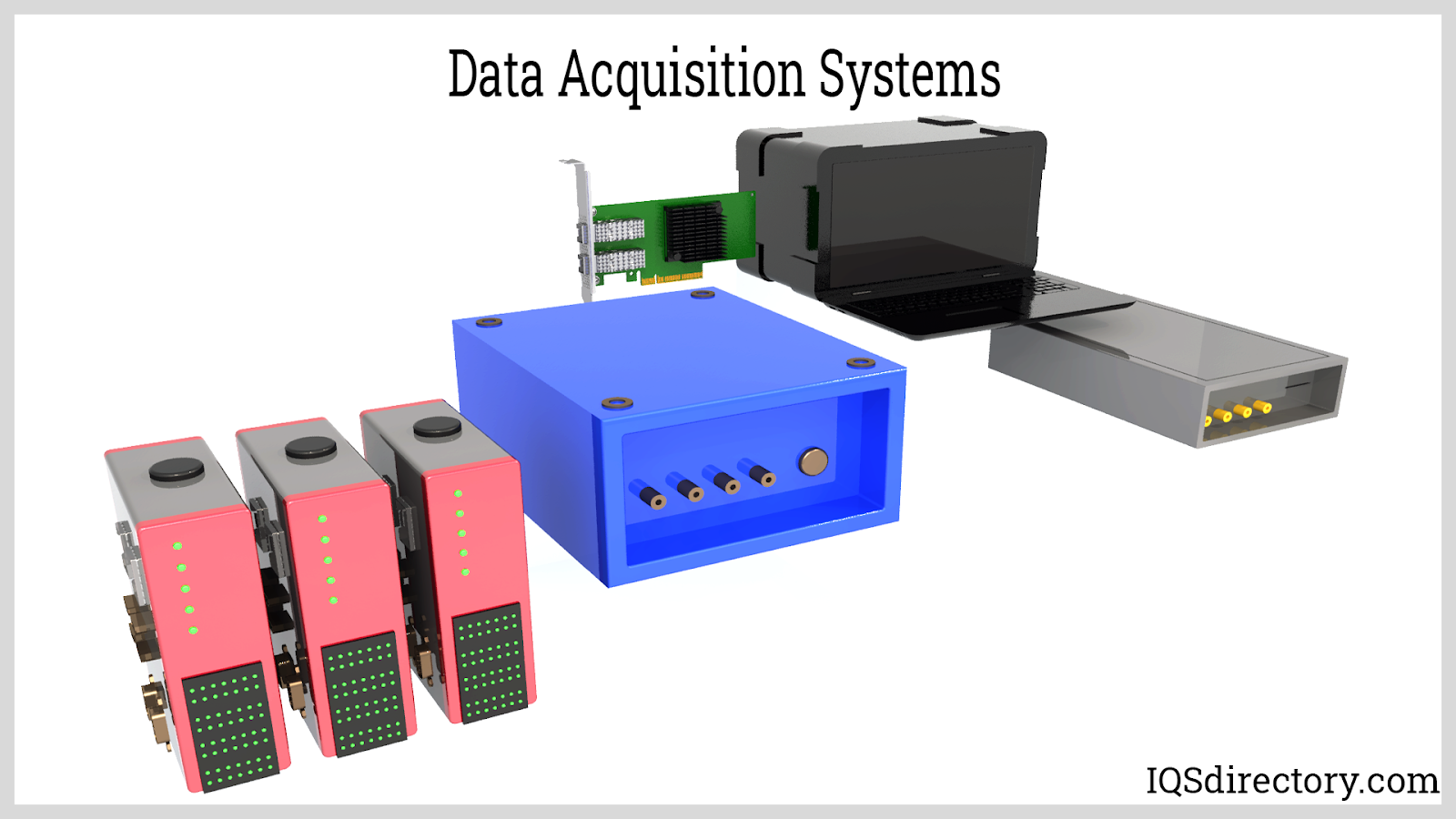 Data acquisition devices contain signal conditioning circuitry, as well as an analog-to-digital converter which needs a computer to function.
Data acquisition devices contain signal conditioning circuitry, as well as an analog-to-digital converter which needs a computer to function.
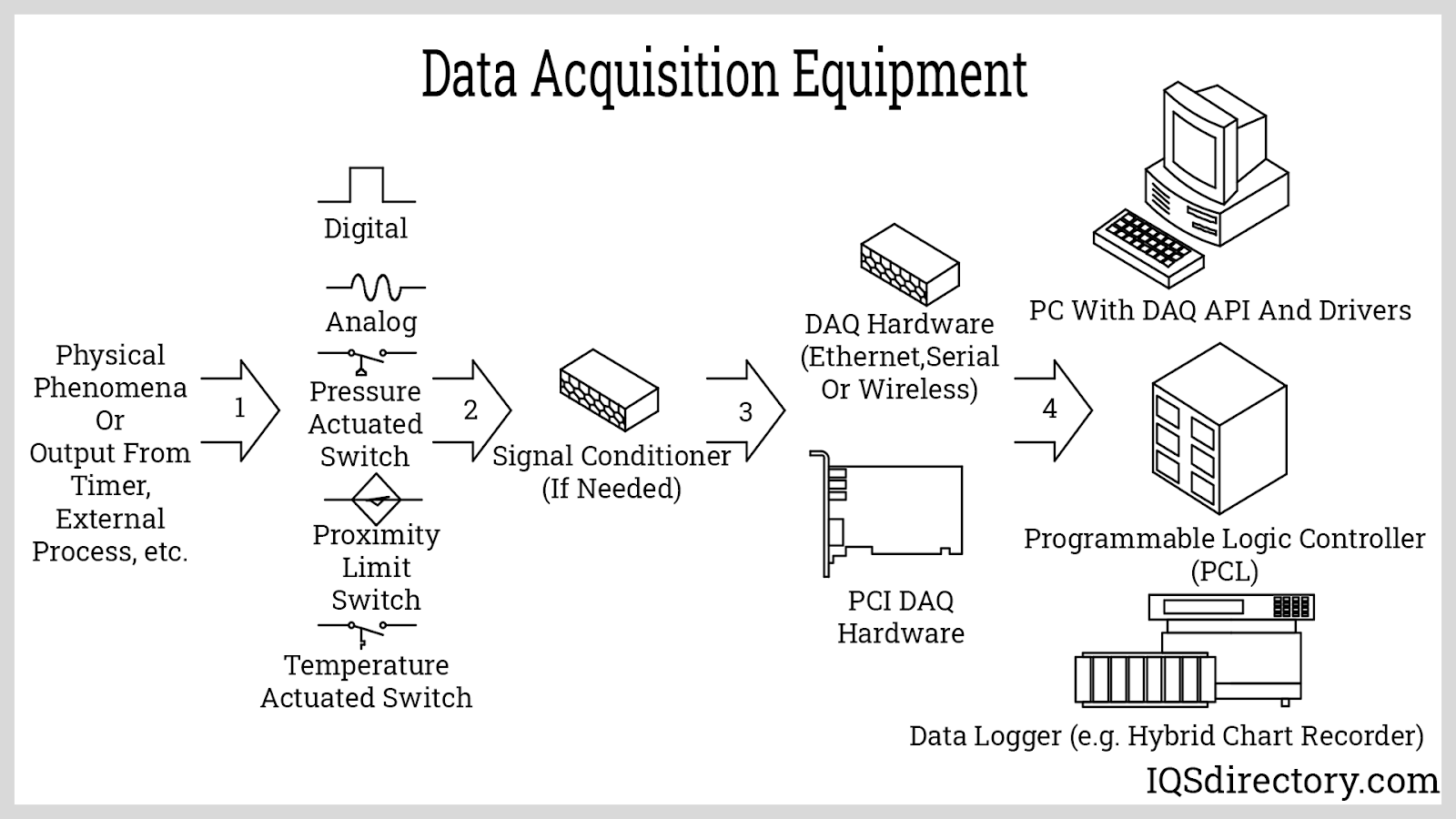 Data acquisition systems require cards to provide the different measurement functions for for acquiring, storing, and processing data.
Data acquisition systems require cards to provide the different measurement functions for for acquiring, storing, and processing data.
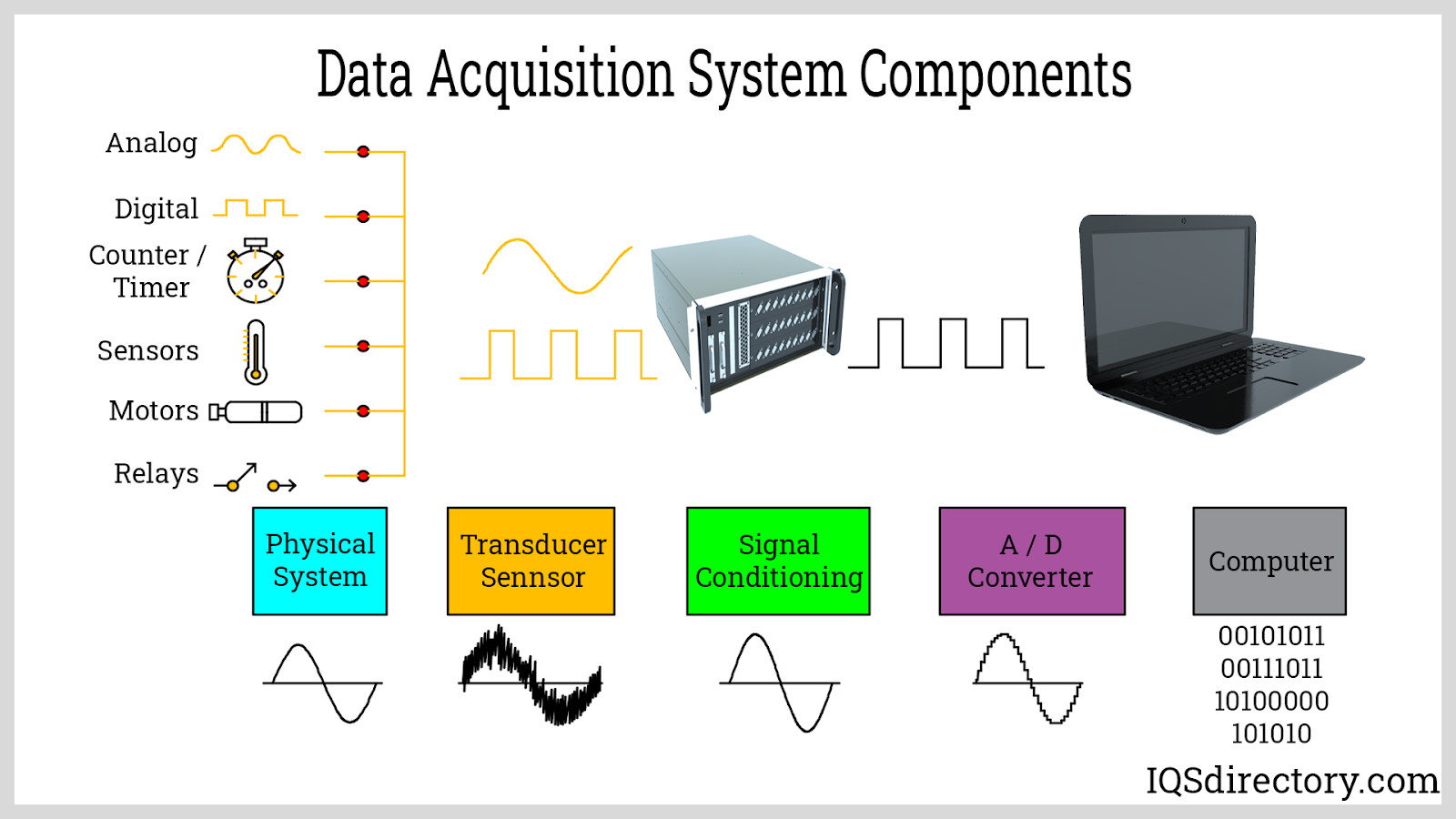 The different components used in data acquisition and what is require for the parts to operate.
The different components used in data acquisition and what is require for the parts to operate.
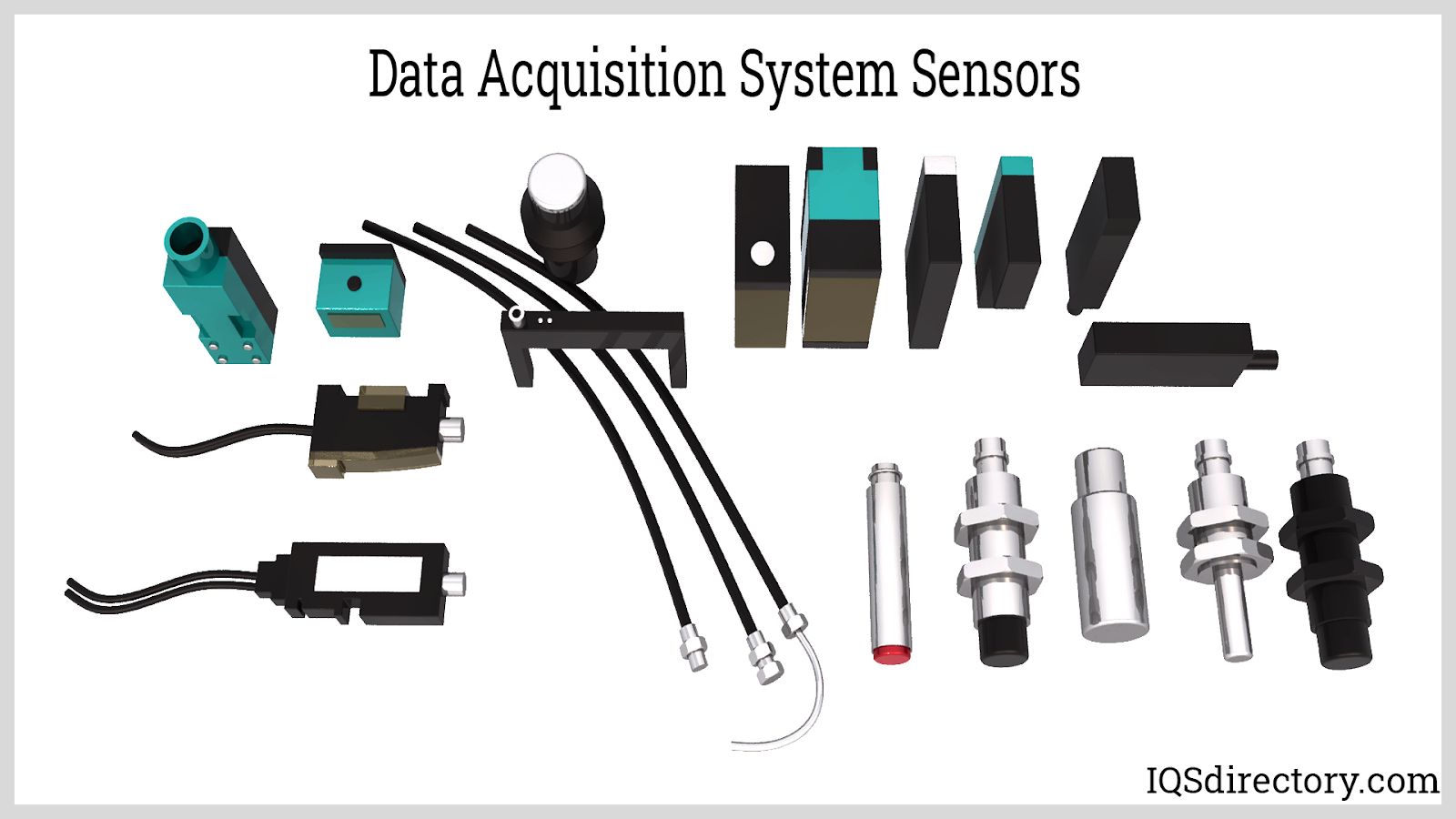 Sensors convert physical values to produce an output of electrical signals.
Sensors convert physical values to produce an output of electrical signals.
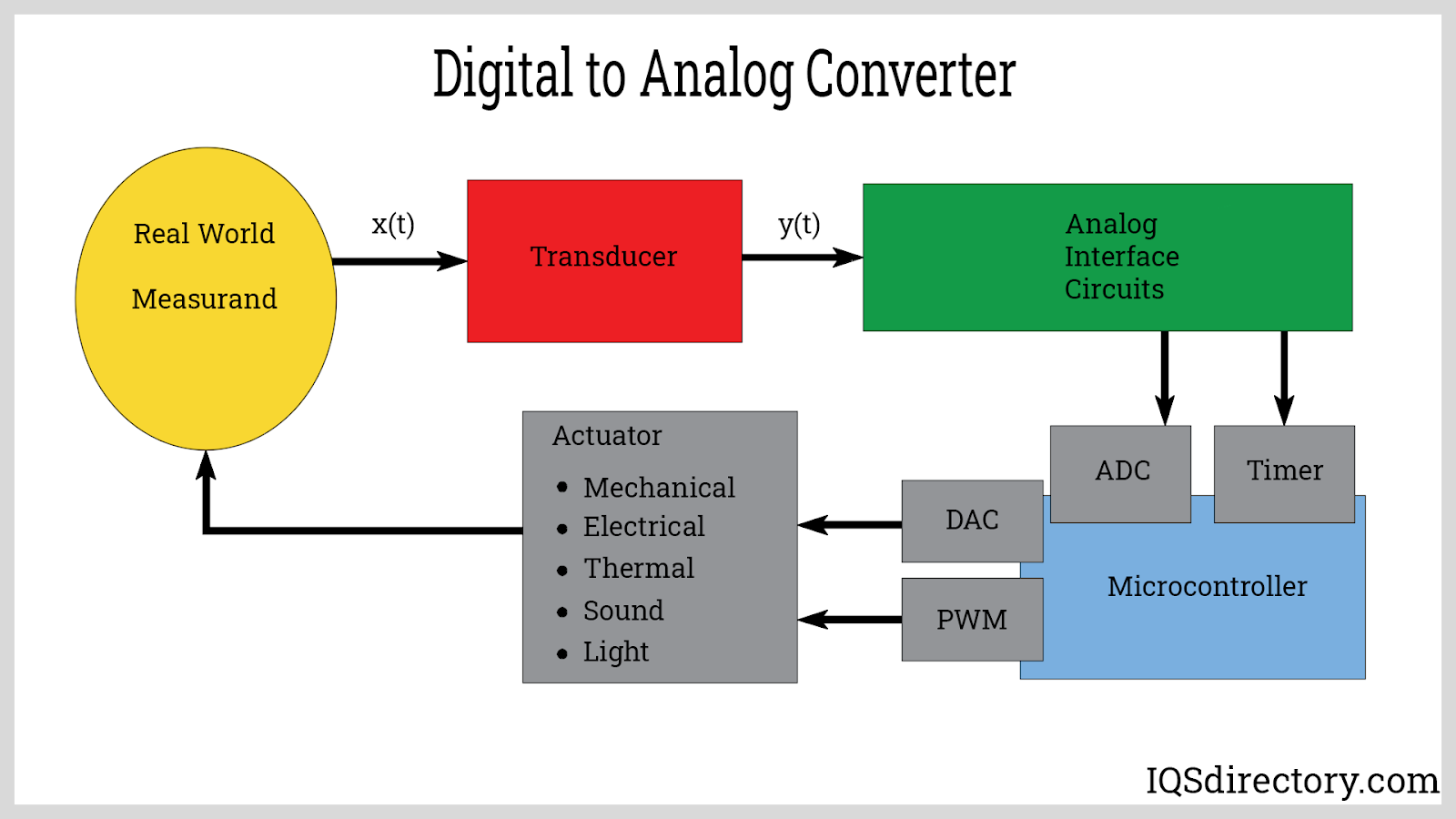 This component provides support for inputting and outputting binary signals.
This component provides support for inputting and outputting binary signals.
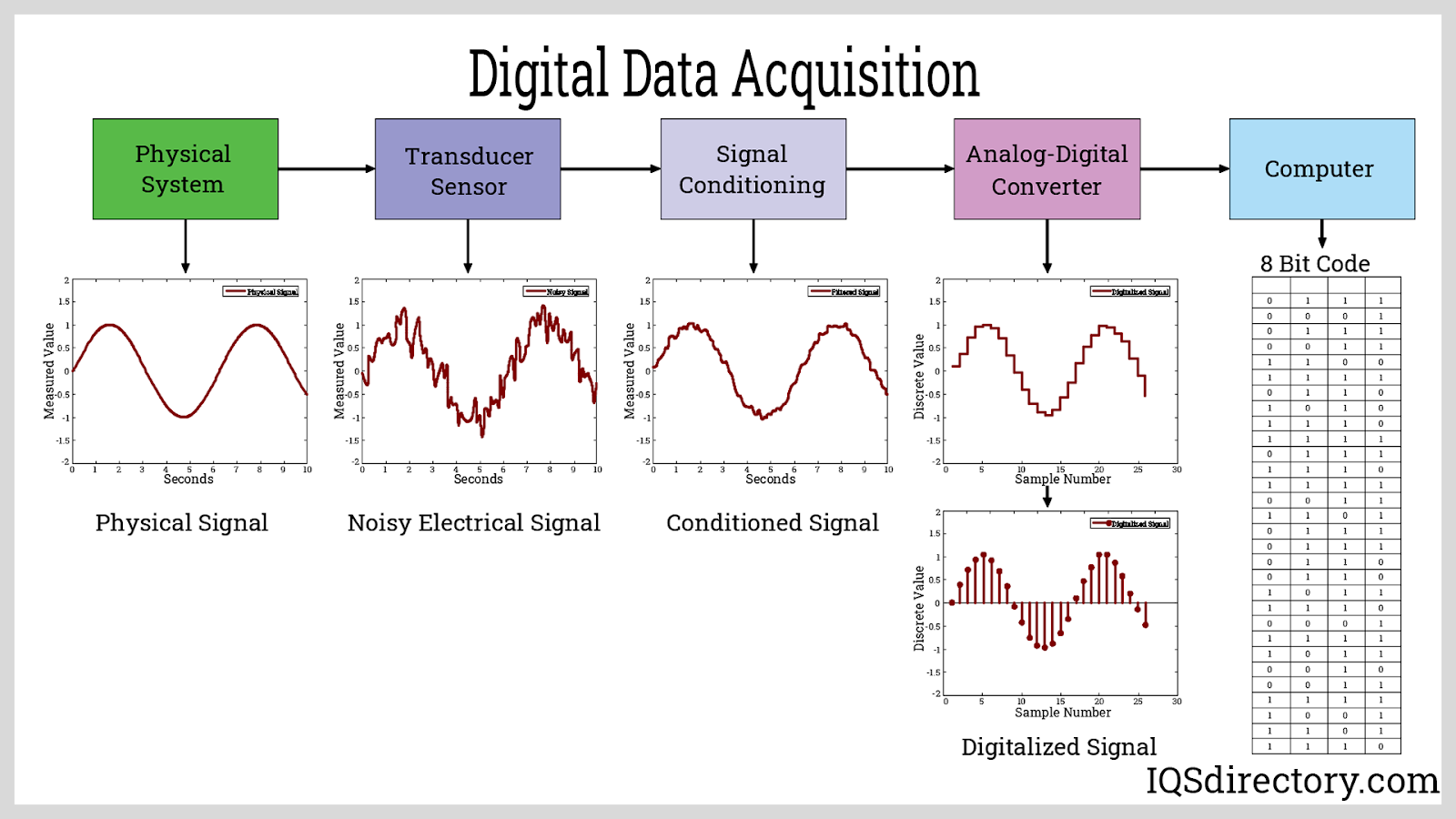 Data acquisition systems uses remote sensing technologies within radar and sonar applications to calculate their efficiency.
Data acquisition systems uses remote sensing technologies within radar and sonar applications to calculate their efficiency.
Variations of DAS
As emphasized before, data acquisition systems are highly variable because the physical data they are dependent on is highly variable. (For instance, measuring temperature and pressure are two distinct processes requiring distinct equipment and/or procedures.) A variety of components, devices and types of data acquisition systems are available to suit many applications. Some of the more well-known variations of data acquisition devices include data acquisition cards and stand-alone DAQ machines (also known as data loggers).
- PC Plug-In Cards
- Data acquisition cards are types of electronic DAQ hardware that must be physically plugged into a computer. More specifically, they are cards that fit into motherboard slots (e.g. PCI or PCI Express). These cards use a bus internal to the PC they connect directly to and are able to directly access a PC’s internal memory. DAQ cards have historically been used to cut overall costs associated with implementing and using DAS overall. However, these type of DAQ systems are limited by factors such as low maximum channel counts and inconsistent accuracy; as a result, they have become increasingly outdated as superior DAS options continue to emerge.
- Stand-Alone Machines (Data Loggers)
- The most distinct type of data acquisition systems are stand-alone data acquisition systems. As their name indicates, these machines are distinguished by their ability to operate independently of a separate PC system. Although they are also able to be used as part of a data acquisition system, stand-alone machines are more commonly utilized separately apart from the requirement of a computer.
- Stand-alone DAQ machines require their own special data logger software or programming, as well as some type of internal memory, to properly function and process data. (SD cards are the preferred memory option for these types of machines.) Even though they are able to operate apart from a separate PC, stand-alone machines are usually equipped with the ability to download data to a PC (via GPIB, USB, etc.) Stand-alone machines are mostly equivalent to data loggers (or data recorders), since data loggers are defined as being any device with the ability of storing data.
- Some examples of specific data logging equipment include plug-in boards and serial communication systems. A good example of a data logger is the temperature recorder. Temperature recorders can be mechanical, analog or digital. After digitizing data concerning temperature (which can be defined as the degree of either hot or cold that characterizes an environment), these machines download information they record to a computer for usage in applications such as laboratory research. Temperature recorders are heavily used in weather stations in order to monitor meteorological conditions.
- Parts & Accessories
- Individual components of DAQ systems can vary as widely as the overall DAQ system itself. The importance of ADCs has already been emphasized. Unsurprisingly, then, these high-speed digitizers can come in a variety of forms. Some specific types include successive approximation ADCs, voltage-to-frequency ADCs, dual slope integrating ADCs, and Sigma Delta ADCs. Another example of a variable DAS part is the application software. As alluded to previously, this software is often based on common programming languages (e.g. C++) and enables a user to customize its functionality. However, some versions of DAS use ready-to-run, prebuilt software which does not require any further programming. The specific software within a DAS also regulates where digital data is stored on the computer (e.g. in volatile RAM or permanent hard drive memory).
- Breakout boxes are just one example of the type of accessories that function within a DAS. If the number of input channels are greater than the number of ports in a DAS, a breakout box can be used to consolidate multiple signals into a single signal that the DAS is then able to properly process.
Applications of DAS
Some of the more common uses of data acquisition systems include testing of all kinds for field studies, troubleshooting and research. Along with monitoring and making appropriate adjustments for processes, manufacturers can test all types of technical products using data acquisition systems.
By use of general-purpose programming, instead of industry or application-specific, data acquisition systems are able to be beneficial for a broad spectrum of industries including: medical, for the acquisition of clinical trial data by means such as central web based systems and local electronic data capture systems; industrial, to acquire data through methods such as chart recorders and PC-based systems; aerospace, for the acquisition of data by means including flight data acquisition units and structural dynamics test systems; and wastewater, in order to collect data for information regarding the toxicity of the wastewater and the effectiveness of the treatment. A partial list of even more specific industries that heavily depend on DAS include food processing, oil refining, the paper industry, the steel industry, chemical manufacturing, the cement industry, and the textile industry.
Supervisory control and data acquisition, or SCADA, is a complex but common form of data acquisition found in many industrial settings. SCADA refers to an entire system of data acquisition devices and sensors networked to a centralized control hub with extensive monitoring and intervention capabilities. SCADA systems can coordinate large-scale industrial processes that often span a wide geographical area. Although variety characterizes SCADA systems just like smaller DAQ units, these systems are divisible into fundamental components such as SCADA software, sensors, field controllers, and network equipment.
Instead of relaying information directly to a computer, sensors and actuators in a SCADA environment connect and relay information to local "computers" known as field connection controllers. These controllers are usually remote terminal units (RTUs) or programmable logic controllers (PLCs). (PLCs are generally more sophisticated and versatile than RTUs.) Field controllers reformat sensor input according to the SCADA system’s telecommunications protocol before relaying this input to the central SCADA hub (which can consist of a single computer or multiple ones). SCADA systems can function on a wired network management system or a wireless network management system. (Modbus RTU is a type of communication protocol specifically intended for SCADA systems, while Modbus TCP is simply Modbus RTU combined with the TCP/IP transportation protocol. Both are widely used in SCADA systems for communication.) Computers in the central SCADA hub are able to automatically react to field information provided by sensors and RTUs; most of them, however, also provide human-machine interfaces (HMI) for end users to view overall industrial process information and manually intervene if so desired. RTUs can receive commands back from the master SCADA hub and perform certain actions based on input provided from the sensors. (Some RTUs, called smart RTUs, do not require central commands to perform simple, logical actions.) SCADA systems are found in a host of production and development environments, including those in the power industry, the water utility industry, the oil and gas industry, the steel industry, the mass transit industry, etc. Measuring and adjusting water flows (for example, from a reservoir to a tank) and mass printing marketing brochures are just a couple of examples of processes that can be regulated by a SCADA operation.
Fundamental Features of DAS
Since data acquisition systems interpret a wide range of physical phenomena in a wide range of environments, these types of systems are highly variable. There are many different components that can be created and integrated when manufacturing data acquisition systems. Many of these components are highly specialized and simply advantageous in certain applications. However, data acquisition systems do share a set of essential components (even though these components may vary somewhat in appearance and function).
Essential components of DAS include sensors, specialized DAS hardware (primarily signal conditioning circuitry plus analog-to-digital converters), and specialized DAS software.
- Sensors
- Also called transducers are necessary in data acquisition systems because they are the means by which physical data is converted to digital values.
- DAQ Hardware
- Functions overall as an interface between the signal and a computer; the majority of hardware sets must be connected to a computer in order to run, although a small number are able to operate independently. Both the signal conditioning circuitry and the analog-to-digital converter are typically classified as part of the overall DAS hardware system. The signal conditioning circuitry (or signal conditioner) also plays a crucial conversion role in the data acquisition process. However, instead of functioning in the same capacity as sensors, the signal conditioning circuitry is used to convert the signals from the sensors into a form that is more readily able to be digitally converted. Analog-to-digital converters are an essential component of data acquisition systems because they are responsible for fully converting the signal after it has been transformed by the signal conditioning circuitry into digital values.
- Software Programs
- Data acquisition systems are both accessed and controlled by data acquisition software programs that utilize a wide range of general-purpose programming languages (such as Java, Pascal, Lisp and BASIC). This programmable software is generally located on a computer, and it processes all of the data that passes through the sensors and the DAS hardware. Once processed by the software component of a DAS, data can be analyzed and practically applied by an end user.
- It is critical to thoroughly discuss your intended DAS applications with any prospective supplier of data acquisition system services or products. You can return to the top of this page to find a list of manufacturers making data acquisition systems of this type.
Data Acquisition System Terms
- Accuracy
- The sum of all factors of error in a data acquisition device.
- Aliasing
- The false reading of high-frequency signals as lower-frequency signals. These readings are expected errors from the discrete calculations with sampling devices like analog-to-digital (A/D) converters.
- Anti-Aliasing Filter
- An apparatus that attenuates the content of signals outside the preferred bandwidth and comes before the analog-to-digital converter (ADC) in instrumentation designs, which, in theory, permits the frequencies only in the pass band to be sampled with the ADC.
- Analog
- A signal that has a value somewhere between two extremes and can constantly change.
- Analog-to-Digital Conversion (A/D)
- The procedure of converting analog signals into a digital value or signal that is then able to be stored on a computer.
- Asynchronous
- Transmission of data between receiving and transmitting mechanisms in the form of zeros and ones. For correct data interpretation, the receiving data needs to start at the appropriate location of the sequence.
- Automated Local Evaluation in Real Time (ALERT)
- Protocol of data transmission for flood warning systems.
- Calibration
- The process of adjusting a device to increase its accuracy.
- Common Mode Range
- The required voltage range as related to the datalogger ground into which both inputs of a differential calculation must fall in order to make a differential measurement.
- Data Retrieval
- Receiving data from an RTU, data logger or field recording apparatus. This process is done locally or remotely, depending on the data retrieval peripheral.
- Differential Input
- An input channel configuration consisting of two signal wires coupled with each input signal, one wire for input and one for return signals. The measurement is the variation of voltage between the wires.
- Differential Measurements
- Analog measurements that measure the voltage between two inputs. Differential measurements are able to reject noise better than single-ended calculations, and can purge errors from differences in ground potential between the sensors and the datalogger.
- Digital I/O Ports
- Input/output ports that sense status, read SDM peripherals or SDI-12 sensors and maintain external devices.
- Excitation
- The electrical current or voltage used with transducers.
- External Signal Conditioning
- The use of a peripheral device to change a sensor’s signal so another non-compatible device is able to read the signal. Signal conditioning mechanisms can be simple or complex.
- Jitter
- The frequent or periodic displacement of a signal away from its intended location.
- Queue
- A temporary storage location for information that has yet to be processed or has not yet been transmitted.
- Resolution
- The lowest vital number at which a measurement is determined.
- Sample Rate
- The pace of measurements.
- Sampling
- Procedure of calculating a signal’s value at discrete time points.
- Sampling Frequency
- Amount of times per second that an analog signal is measured as A/D conversion occurs.
- Sensitivity
- A measure of the minimum amount of change in a signal that an instrument can detect.
- Sensor
- A device that responds to a physical stimulus and generates an electrical signal or alters an electrical property, such as resistance. The stimuli can be things like light, sound, heat, pressure and motion.
- Supervisory Control and Data Acquisition (SCADA)
- System that correlates redundant data storage with measurement regulation, typically for regulating a manufacturing process. Water treatment plants generally use SCADA systems.
- Transducer
- A sensor that converts energy into readable electrical signals, which data loggers measure and record. Examples of these include thermocouples and strain gauges.